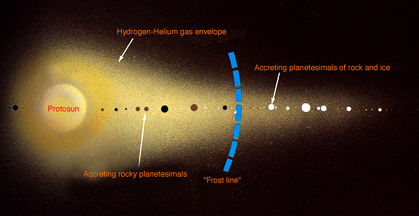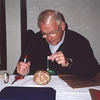This drawing depicts a position where the formation of ice became important.
Click on image for full size
Windows Original
The position of Neptune when gas changed to ice
The position of the planets in the solar nebula greatly affected their 1. size and 2. composition. This is because of the effect of how cold it was in the nebula.
1. The nebula was a lot warmer close to the proto-sun. The blue line shown in the picture shows the point at which the temperature became cold enough for gases to become ice. At this point and further out, the materials that forming planets (proto-planets) began to extract from the cloud were ice, as well as rocky material and gas molecules. Retention of ice resulted in these proto-planets becoming giant, massive planets. (The same thing happens to raindrops when it becomes cold enough for the raindrops to become slushy snow drops, the drops are more massive). Planets which formed closer to the proto-sun were smaller, and more rocky.
Neptune was farther out in the nebula, however, where the cloud was not only becoming colder, but becoming thinner as well. This meant that there was less gas to sweep up, so proto-Neptune was not able to sweep up as much gas as the proto-Jupiter. Thus Neptune is much smaller than Jupiter.
2. Neptune (unlike Jupiter) is made of complex molecules, and not a simple molecule like hydrogen. That is because near the proto-Neptune, the temperature was so cold that even methane and ammonia, which normally would drift away, solidified into ice and were drawn to the forming planet.
You might also be interested in:
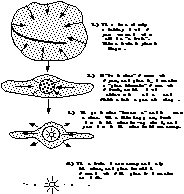
The solar system contracted, or shrank together, out of a spinning cloud of hydrogen and helium gas. This spinning cloud had a certain amount of momentum, which caused it to flatten, somewhat the way a
...more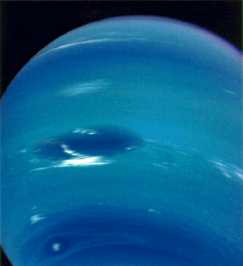
Atmospheres of the giant planets have definitely evolved from their formation out of the primitive solar nebula. How much they have evolved remains to be seen, however. Because of their enormous gravity,
...more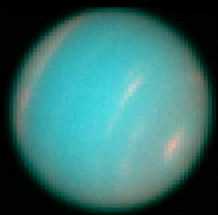
This image shows the new Great Dark Spot of Neptune, which was discovered using the Hubble Space Telescope. The image shown here, shows a "hole" in the clouds of Neptune in pink, in the northern hemisphere,
...more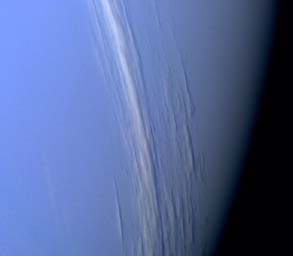
This image shows some cirrus clouds, extending for many kilometers across the disc of Neptune. These clouds are somewhat high up, for they can be seen to cast shadows on the lower clouddeck, which is 35
...more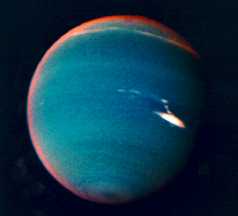
This image of Neptune uses false colors to bring out the hazes of smog, which can be seen in red along the limb of Neptune, at the edge of the picture. These hazes of smog are found at very high altitudes,
...more
Like Jupiter and all the giant planets, Neptune's appearance shows a striped pattern of clouds. Other cloud shapes seen over time include a small dark spot, the "scooter" and the Great Dark Spot. The Great
...more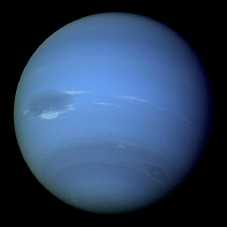
If you had a quiz question in school that asked what year Neptune was discovered, you'd probably choose 1846. But Neptune wasn't discovered the way all the other planets in our solar system were. Astronomers
...more
In astronomy, it is a usual procedure to calculate the luminosity of a star, and this calculation indicates the energy and the temperature of the star. When the luminosity of the outer planets was calculated,
...more


